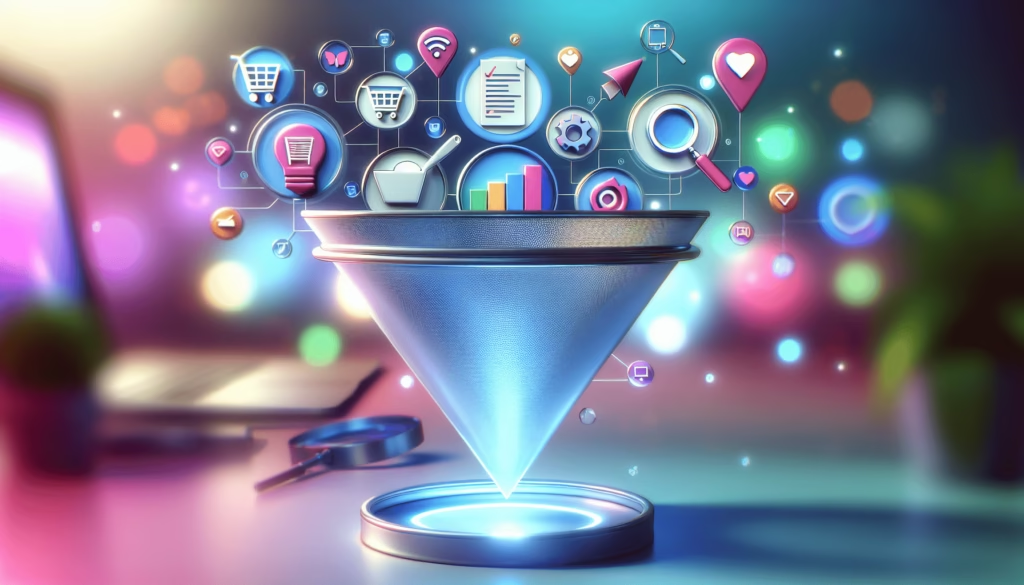
What if your digital business had a steady stream of customers flowing into it every day? Imagine the impact on your revenue, your brand, and your overall peace of mind. Creating a sales funnel can help you achieve just that. With a clear path for potential customers to follow, you turn cold leads into loyal clients. Let’s break down the process of creating an effective sales funnel for your digital business.

Table of Contents
Understanding the Sales Funnel Concept
At its core, a sales funnel represents the journey that potential customers take from discovering your business to making a purchase. It’s like a map that guides them through various stages, each designed to warm them up and lead them closer to that final decision.
Why Do You Need a Sales Funnel?
A sales funnel is crucial because it allows you to systematically address the needs and concerns of your audience. When you understand where your customers are in the journey, you can provide tailored content that speaks to them directly. This targeted approach increases the likelihood of conversion.
The Stages of a Sales Funnel
The traditional sales funnel consists of several key stages:
- Awareness: This is when potential customers first discover your business.
- Interest: They seek more information and express interest in your products or services.
- Decision: Here, they evaluate your offering against competitors and weigh their options.
- Action: This is the final stage, where the customer makes the purchase.
Each stage requires unique strategies to encourage progression. You need to build trust and provide value at every step.
Building Your Sales Funnel
Creating your sales funnel involves several steps. Let’s break it down for clarity.
Identifying Your Target Audience
Before you can build an effective sales funnel, you need to identify who your ideal customers are. This involves creating buyer personas that provide insights into their needs, preferences, and pain points.
Tips for Identifying Your Audience
- Conduct Surveys: Use tools like Google Forms or SurveyMonkey to gather data directly from your audience.
- Analyze Your Competitors: Look at whom they are targeting. What do their customers care about?
- Utilize Social Media Insights: Platforms like Facebook and Instagram provide demographic data on who’s engaging with your content.
Creating Compelling Content
Content will play a significant role in driving your audience through the funnel. From blog posts to videos, each piece should aim to educate, provoke thought, and invite engagement.
Different Types of Content to Consider
| Content Type | Purpose | Formats |
|---|---|---|
| Blog Posts | Establish authority, provide value | Articles, Guides |
| Videos | Offer a personal touch, visually engaging | Tutorials, Explainers |
| Social Media Posts | Encourage interaction and sharing | GIFs, Images |
| Email Newsletters | Nurture leads, keep your audience informed | Regular Updates |
| E-books/Whitepapers | Position yourself as an expert, provide in-depth knowledge | Downloadable Content |
Designing the Funnel Stages
Now that you know your audience and what content appeals to them, it’s time to design the funnel structure. Each stage will have specific content and calls-to-action (CTAs).
Awareness Stage
This is all about capturing attention. Use social media platforms, blog posts, and paid ads to reach a broader audience. Your goal is to inform them about your existence.
Tips for the Awareness Stage:
- Use eye-catching visuals and headlines.
- Create content that addresses common problems within your niche.
- Optimize for SEO to increase organic traffic.
Interest Stage
Now that potential customers are aware of you, it’s time to showcase the value you provide. Here, you want to deepen their interest through more engaging content.
Strategies for the Interest Stage:
- Webinars and live Q&A sessions to provide direct value.
- Case studies or testimonials to bolster credibility.
- Free resources like checklists or workbooks that require an email signup.
Decision Stage
This is where you help them compare options and highlight the advantages of choosing your product. Make it as easy as possible for them to decide.
Approaches for the Decision Stage:
- Offer a free trial or demo of your products.
- Provide comparison charts that show how you stack up against competitors.
- Highlight promotions or limited-time offers to create urgency.
Action Stage
Finally, it’s essential to make purchasing easy. Streamline the checkout process and remove any roadblocks that might deter a sale.
Tactics for the Action Stage:
- Use clear, persuasive CTAs on every page.
- Offer multiple payment options to accommodate different preferences.
- Send follow-up emails to remind those who have abandoned their carts.
Tools to Help You Build a Sales Funnel
Creating a sales funnel may sound daunting, but various tools can simplify the process considerably. Here’s a list of essential tools that can help you at each stage of your funnel.
Website Builders
An optimized website is critical for your sales funnel’s success. Platforms like WordPress, Squarespace, and Wix allow you to create visually appealing and functional sites without extensive coding knowledge.
Email Marketing Software
Once you capture leads, you need a reliable way to nurture them. Email marketing services like Mailchimp, Constant Contact, and ConvertKit can help automate your campaigns, segment your audience for targeted messaging, and track performance metrics.
Landing Page Builders
Creating dedicated landing pages for your offerings helps focus your audience’s attention. Tools like Unbounce and Leadpages allow for easy creation of optimized landing pages designed specifically to convert visitors.
Customer Relationship Management (CRM)
Utilizing a CRM system like HubSpot or Salesforce can help you track interactions with leads and customers. This aids in personalizing your communications and improving follow-up strategies, ultimately enhancing your sales funnel’s effectiveness.
Analytics Tools
Tracking your funnel’s performance is essential. Google Analytics provides invaluable insights into where your leads are coming from and where they drop off in the funnel. This data is critical for ongoing optimization.
Optimizing Your Sales Funnel
Creating your sales funnel is one thing, but keeping it effective requires ongoing analysis and optimization. Regular review and adjustments can dramatically improve conversion rates over time.
A/B Testing
Consider setting up A/B tests to compare different elements of your funnel, such as headlines, CTAs, or email subject lines. This data-driven approach can help you understand what resonates best with your audience.
Analyzing Metrics
Keep an eye on key performance indicators (KPIs) that reflect how well each stage of your funnel is performing. Common KPIs include:
- Click-Through Rates (CTR): The percentage of people who click on your links and calls-to-action.
- Conversion Rates: The percentage of leads who make a purchase.
- Lead Drop-Off Rates: The percentage of leads that fall off at each stage of the funnel.
Gathering Feedback
Soliciting feedback from customers can provide unique insights into how your sales funnel can be improved. Consider sending post-purchase surveys or maintaining open channels of communication on social media.

Common Mistakes to Avoid
Even experienced marketers can fall into traps while creating a sales funnel. Here are some common mistakes you should be cautious of:
Not Defining Your Audience Clearly
Without a clear understanding of who your audience is, it’s challenging to create relevant content. Invest time upfront to define and understand your buyer personas.
Overloading the Funnel with Content
While diverse content is essential, too much information can overwhelm potential customers. Aim to provide clear, concise content that addresses their immediate needs without unnecessary clutter.
Ignoring Mobile Optimization
With the growing use of mobile devices, neglecting to optimize your funnel for mobile can lead to loss of potential customers. Ensure that your website and elements are responsive and mobile-friendly.
Failing to Follow Up
Once a potential customer shows interest, it’s vital to follow up promptly. Automated email sequences can nurture leads and keep your business top-of-mind.
Conclusion
Creating a sales funnel may seem intricate, but it’s a manageable process when broken down step by step. With a clear understanding of your audience, thoughtful content creation, and ongoing optimization, you’ll be well on your way to efficiently converting leads into loyal customers.
As your digital business grows, remember that refinement is key. Continually assess how your funnel performs and make adjustments based on feedback and analytics. In doing so, you’ll not only enhance your customer’s journey but also increase your overall sales effectiveness. Now, it’s time for you to implement these strategies and watch your digital business flourish!







